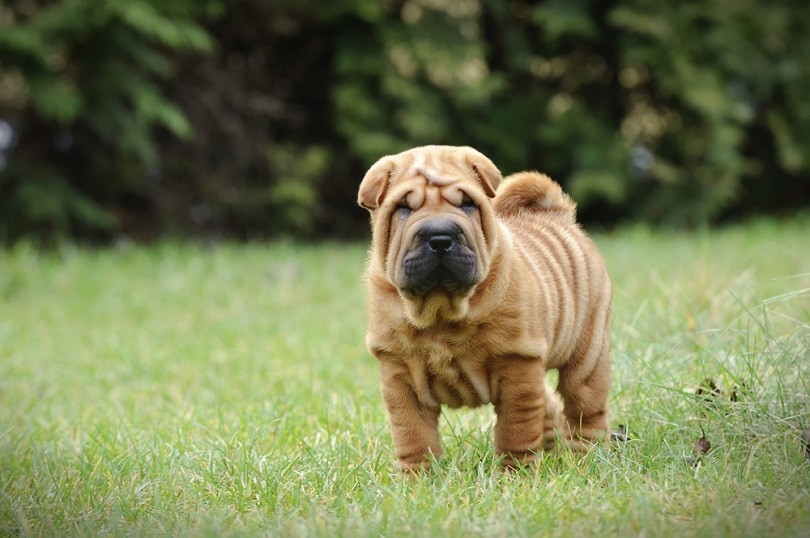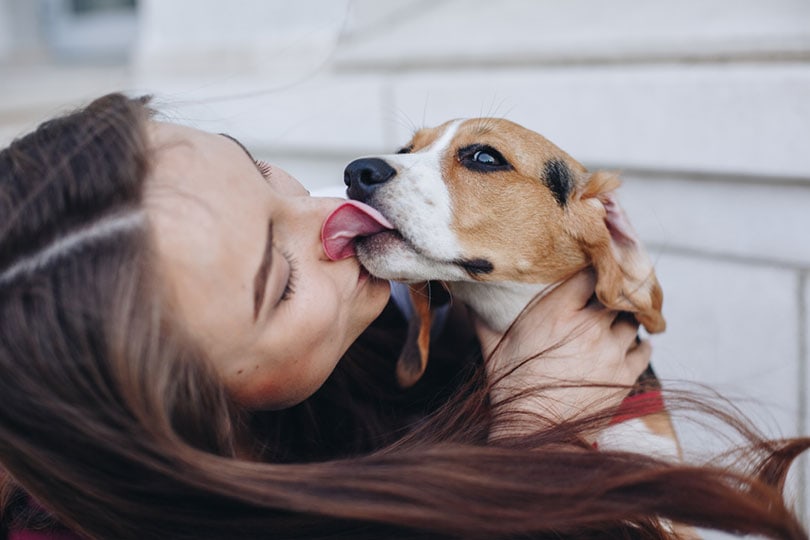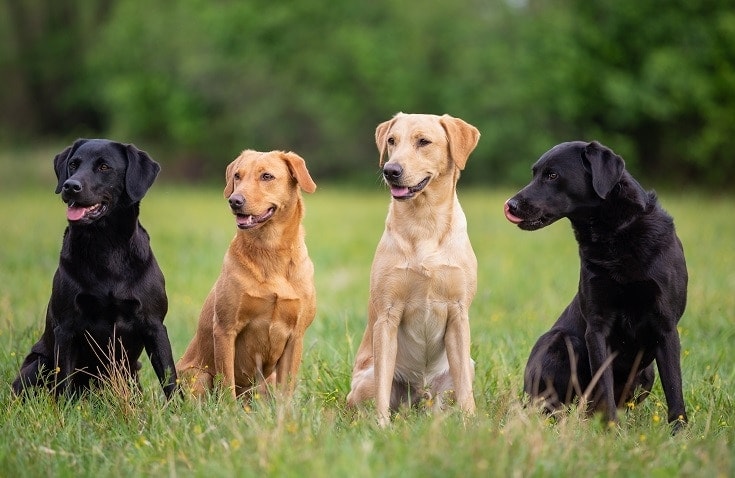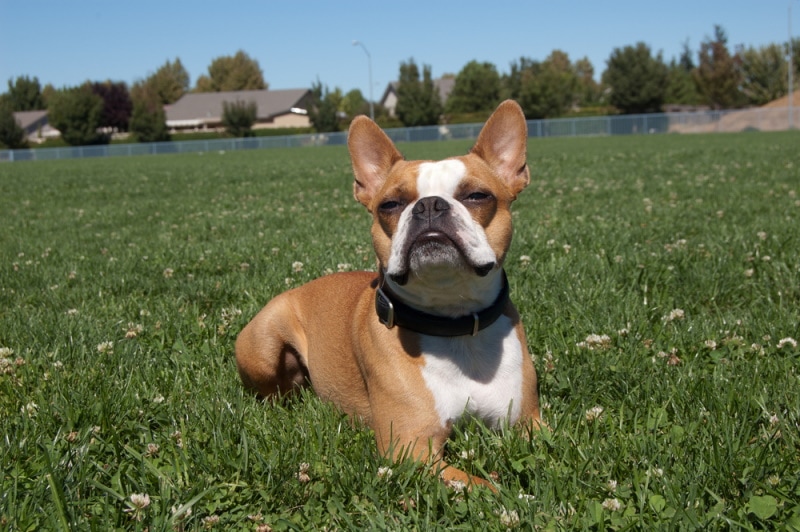How to Train a Shar Pei: 16 Vet-Approved Tips & Tricks
By Hanh Duong
Updated on

Shar Peis are wise, loyal, and will always have your back. But you have to train them right to ensure they become the best companions they can be. Early socialization and training are vital to channeling their instincts, which were honed over centuries of standing guard. But don’t worry if your new furry friend is a little stubborn; you’ll be able to work with them and get them trained in no time.
We’ve got 16 vet-approved tips and tricks to help you out, so let’s get started!
The 16 Vet-Approved Tips & Tricks on How to Train a Shar Pei
1. Lay a Solid Foundation First
Training your Shar Pei to come when called is an important task, but you need to create a strong bond with your pet before that. Spend some fun time with your dog, play games, and give them treats and compliments to make them feel special.
Building trust and a strong connection with your Shar Pei will make them more likely to listen to your commands.
2. Use Positive Reinforcement Methods
As a loving dog owner, you always want to give your furry friend the best training possible. Most veterinarians agree that positive reinforcement training is the way to go. It’s simple yet incredibly effective and works by rewarding your pup for good behavior rather than punishing the bad. So, next time your dog obeys your command or demonstrates good behavior, don’t hesitate to reward them with a treat, a toy, or even a belly rub. Believe it or not, you’re not just making your dog happier. You’re also reinforcing the association between good behavior and good things.
However, you must be careful not to reward unwanted behavior by mistake. For instance, if your dog barks at you to play or jumps up to say hello, don’t give in to their demands. Instead, wait until they calm down before showering them with attention.

3. Get the Appropriate Reward
Training your dog can be awesome, but every dog is different and has their own way of responding to rewards. Some dogs are all about the food and will do anything for a treat, while others might be pickier about what they eat. For example, some canines might prefer soft, chewy treats over crunchy ones, or they might not be interested in food at all.
Don’t sweat it if that’s the case with your furry friend. There are other rewards you can try, like playing with their favorite toy or giving them lots of love and praise. Just remember that every dog is unique, so you might need to mix it up a bit to find what works best for your best companion.
4. Find the Appropriate Reinforcer
Training your dog can be awesome, but every dog is different and has their own way of responding to different reinforcers and rewards. Some dogs are all about the food and will do anything for a treat, while others might be pickier about what they eat. For example, some canines might prefer soft, chewy treats over crunchy ones, or in certain scenarios, they might not be interested in food at all.
Don’t sweat it if that’s the case; instead, try to better know your furry friend’s preferences. There are many reinforcers you can try, like playing with their favorite toy or giving them lots of love and praise. Just remember that every dog is unique, so you might need to mix it up a bit to find what works best for your best companion.

5. Don’t Delay Starting Training
Teaching your Shar Pei good things can save their life in emergencies. Start by training them in a calm, controlled environment, such as your home or a fenced yard. To help your furry friend focus on the new command, limit distractions in the early stages of training.
However, it would help if you knew that certain types of training should be done at different ages. For example, most puppies don’t get complete control over their bladder until they’re around 15–16 weeks old. Therefore, potty training them before that needs to be adjusted to realistic expectations, and you will need to take them out every couple of hours. Start teaching your pup early, but also be aware of their capabilities depending on their age.
6. Prioritize Grooming
If you chose a Shar Pei as a pet, chances are you adore their wrinkly looks. Who wouldn’t? They are so cute! However, please keep in mind that throughout your pup’s life, you will have to regularly inspect the skinfolds and make sure they are kept clean and dry to prevent bacterial or fungal infections. It is best to use positive reinforcement techniques to train your Shar Pei to allow you to regularly inspect and manipulate their skin fold to ensure they are healthy and help prevent the development of lip-fold pyoderma.

7. Practice Little and Often
Short training sessions throughout the day are more effective than long ones. You don’t want to bore your dog or frustrate them, so it’s best to keep the sessions under 5 minutes or so.
Here’s another thing: most dogs find it challenging to be attentive and responsive in different situations, which means that they might not respond to the same command outside of the familiar setting. That’s why it’s essential to repeat your training sessions in multiple locations, with different people, and varying levels of distraction. By doing so, your pup will learn to respond correctly to the same command all the time, no matter where they are.
8. Start Training Your Dog in a Controlled Environment
Teaching your Shar Pei good things can save their life in emergencies. Start by training them in a calm, controlled environment, such as your home or a fenced yard. To help your furry friend focus on the new command, limit distractions in the early stages of training.
As your pup becomes more proficient, you can gradually introduce distractions and practice in a variety of settings like parks or busy streets.

9. Finish Each Training Session with Praise
Teaching your furry friend new tricks and behaviors can be a fun and exciting experience, but it’s important to remember that your pup’s skills are limited when you first begin training. Starting with simple, one-word verbal commands like stay, sit, down, and paw is the best way to get your pup accustomed to following your lead. Avoiding complex sentences or multi-step instructions can help your dog focus on the task and avoid confusion.
So, whether you’re starting with a new puppy or working on training an older dog, remember to keep it simple and stick to the basics for the best results.
10. Make it Enjoyable
Both you and your dog should enjoy training! Always remain positive, and experiment with variety to keep things enjoyable, such as adding brief breaks for play into your workouts in between repetitions. In addition to regular obedience training, you can think about teaching your dog tricks.
When we see a dog turn over rather than just sit, we naturally react more positively as humans. Our dogs take up this positivity and end up enjoying performing tricks for us.

11. Discourage Jumping
Who doesn’t love a furry little pup springing up to greet you? But sometimes, even adult dogs can get carried away with their exuberance. If your dog jumps up to say hello, don’t scold them. Instead, simply turn away, ignore their antics, and wait until they calm down before rewarding them with love and attention.
Remember, never reward your dog for jumping up on you or anyone else; this will only encourage bad behavior.
12. Begin Socializing Immediately
Introducing your furry little friend to new people, places, and other pets is an exciting way to help them get accustomed to various situations. While some vets advise not taking puppies out in public until they have received all of their vaccinations at 16 weeks, the American Veterinary Society of Animal Behavior (AVSAB) suggests that socialization should begin even before they are fully vaccinated. Our advice is to ensure your puppy has the first round of vaccinations, then socialize them in a controlled setting exposing them only to familiar dogs who you know are healthy and have a complete vaccination schedule.

13. Be Ready for Both Ups and Downs
When starting dog training, every dog owner must prepare themselves mentally. Brace yourself for the rollercoaster ride of ups and downs in the training cycle. Some days, it’ll feel like you and your furry friend are in perfect sync—nailing every command. On other days, you might find yourself struggling to get your pup, even to pay attention.
But don’t worry too much about a “bad” training session. Remember, training is not a sprint. It’s a marathon. So, keep your chin up and keep pushing forward. With time, patience, and consistency, your furry friend will master every command.
14. No Nipping and Biting
If your new furry buddy is always nipping or biting, don’t worry! You can try some easy tricks to get them to stop without getting upset. First, try giving them a chew toy instead of your fleshy limbs—many dogs prefer these anyway! And if your little troublemaker still doesn’t quit, try ignoring them for a bit after they bite; this can work wonders in showing them that biting won’t get your attention.

15. Finish Each Training Session With Praise
Your furry friend has been putting in a lot of effort to make you proud during training sessions. Why not show them some love in return? Give them some cuddles, praise, a yummy treat, or a quick playtime when the lesson finishes.
Doing so will make them feel special and appreciated, and they’ll be even more eager to show off their new skills at their next training session with an adorable wagging tail!
16. Ask for Assistance
Some dogs require additional training and can be challenging to handle on your own. Why not contact a professional trainer, your local pet community, or your trusted vet for some advice and guidance? They can give you the lowdown on all the best tips and tricks for dealing with any behavioral issues your dog might be facing.
Not only will seeking professional help benefit your furry friend, but it’ll also help you become a more confident and effective trainer.

Conclusion
If you have a Shar Pei you know how stubborn and independent they can be at times, especially regarding recall. I’ve got you covered with some tips and tricks to make the process of teaching your furry pal easier. What you need is some patience, consistency, and positive reinforcement techniques to overcome their independent streak and build a strong recall behavior.
These 16 vet-approved tips and tricks will make training your Shar Pei a fun and rewarding experience!
Featured Image Credit: Waldemar Dabrowski, Shutterstock













